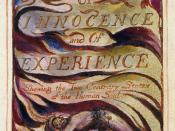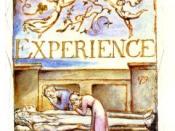At first glance, the poem, "The Garden of Love" may appear simplistic and even depressing Blake writes most often in regular rhythm, seemingly sticking to the rules, blunt observations on such subjects as tigers, lambs and roses. At first glance one might think it was supposed to be a dismal look on how we are much happier as naive children. "Tomb stones where flowers should be" could be thought to mean that tombstones are sad things for children. (line 10).The speaker of the poem tells of his visit to the Garden of Love and of the chapel that is now where he used to play as a child. Instead of welcoming him in, the chapel has 'Thou shalt not' of the Ten Commandments written over the door. At first glance you might think that "experience" or the loss of innocence has destroyed the garden as well, transforming the 'sweet flowers' to graves and tombstones.
These tombstones and the flowers were always there, but simply not seen as negative things when the speaker was a child. But if one were to finish and move on, left with only these initial impressions, it would be a great pity not to have found the deeper meaning in this work.
The secret to the poem lies in its second line. The speaker is talking about the change in how he now sees his surroundings, not a change in the garden itself. The poem marks the passage from childhood innocence to adult experience. There are strong elements of the passage from innocence to Adam and Eve in the Garden of Eden. Just as the biting of the apple interpreted as a sexual awakening, so is the speakers 'joys and desires' include the pleasures he is denied by the rules of morality set by...


